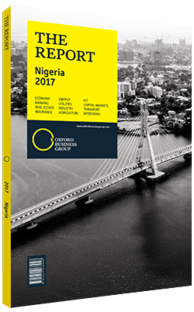Nigeria uses international debt markets to fund its budget
Nigeria has seen notable success in recent months on global debt markets. In February 2017 the government issued a 15-year, $1bn dollar-denominated eurobond at a yield of 7.9%, which was eight times oversubscribed. The following month it issued an additional $500m eurobond at a yield of 7.5%, testament to the continued appetite for debt in Africa’s largest economy.
The February and March issuances will be consolidated, and the combined $1.5m will be due in February 2032. The proceeds from these bonds will be used to fund capital projects highlighted in the budget of President Muhammadu Buhari’s administration.
The debt issuances were well timed: with uncertainty in the US and UK over election outcomes, there was strong demand for emerging market debt and the relatively high yields that come with it. However, the push to boost borrowing to fund the government’s infrastructure initiatives also highlights the potential risks of increasing the country’s debt burden.
Borrowing Targets
The government has set a target of $3.5bn in foreign borrowing to support its $23.1bn budget for 2017. In addition to the $1.5bn already raised, Nigeria expects a $1.3bn loan from the World Bank and $400m from the African Development Bank. The remaining $350m will be raised from sources, such as bilateral loans, commercial loans and tapping of international debt markets. The Federal Ministry of Environment has also announced plans to issue an N20bn ($70.7m) green bond to fund carbon reduction projects and the development of renewable energy.
Increasing debt by $3.5bn in 2017 will not pose an immediate risk to the government. According to a brief by the Nigerian Economic Summit Group (NESG), the country fares well compared to most of its developing world peers, where debt-to-GDP ratios of 40% are common. However, over the past nine years the public debt has grown by an annual average of 24%, according to the NESG. This has driven up debt servicing costs. As a result, the country’s revenue-to-debt servicing ratio deteriorated significantly in 2016. According to the IMF, the ratio of federal government interest payments to revenue doubled to 66% by the end of 2016.
Impact
The impact of this is noticeable. The amount that the government spent in the eight years leading up to 2016 on debt servicing – N6.9trn ($24.4bn) – is equivalent to roughly three-quarters of total spending on capital projects such as infrastructure during the same period. In 2017 the debt servicing cost in the annual budget is equal to one quarter of total spending.
Among the most prominent effects is the influence government borrowing has on domestic credit provision and intermediation. At the end of 2016, 84.7% of total federal debt was sourced domestically, up from 48% in 2005, and with high interest rates on government securities – sometimes exceeding 19% – banks have a reduced incentive to lend to the private sector. To help reduce the crowding out of private sector debt, the IMF recommended that Nigeria reduce its domestic borrowing to around 60%. This would provide benefits beyond freeing up space for more aggressive lending, according to Henry Okoye, trading and fixed-income analyst at Coronation Merchant Bank. “From a fiscal standpoint, borrowing internationally is cheaper,” Okoye told OBG. “Also, many of the capital projects and sectors that the government wants to support would need more foreign currency than local currency.”
Olusegun Omisakin, head of research at the NESG, also noted that given the current low oil price and level of tax collection, Nigeria faces the risk of “falling into the debt trap” should revenues fail to rise at rates above those of debt servicing costs. The 2017 budget document stipulates that debt servicing will equal roughly one-third of total revenues, which remain largely dependent on oil revenues. “Nigeria’s high-interest-rate environment and low patronage of concessionary loans, which are accompanied with lesser servicing cost, will continue to raise debt servicing cost in the short to medium term,” Omisakin told OBG.
You have reached the limit of premium articles you can view for free.
Choose from the options below to purchase print or digital editions of our Reports. You can also purchase a website subscription giving you unlimited access to all of our Reports online for 12 months.
If you have already purchased this Report or have a website subscription, please login to continue.

